Nevill Ground - By ‘Royal’ Appointment

County cricket is a changing business these days, so there's no divine right to an outground's place on the fixture card. There's no suggestion that the Nevill will lose its roll for Kent County Cricket Club, but the standard of pitches required by the ECB and all counties keeps being cranked up.
I'm here to meet the man who has been brought in to see that Kent matches - and those for main summer tenants of the council owned ground, Tunbridge Wells Cricket Club - are played on the best possible surface.
Jon Buddington is a Mackem, and there aren't many in Tunbridge Wells who know what that means, let alone support Sunderland. He was appointed head groundsman at the Nevill last June by Sodexo, the contractor engaged by Tunbridge Wells Borough Council to look after all of the Spa town's open spaces for sport and recreation.
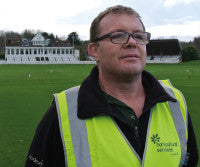
Chairman of Tunbridge Wells Cricket Club, Mark Williams, who welcomes me to the pavilion, is full of praise for the Nevill's new head groundsman.
"Jon has been an absolute revelation and has brought in a new enthusiasm and new ideas. His attention to detail is phenomenal," he said.
Last July, Kent's LV Division 2 Championship match here saw the county record a massive 688-8 declared; its highest ever tally on a home ground and third highest Kent score in history. Apart from helping to trounce Essex, it perhaps laid down a marker for how Jon Buddington was going forward with the Nevill's pitches. He'd only been in charge for three weeks, but in that short time got a strip that played fast and true with something for bat and ball. It was in the record books for all the right reasons.
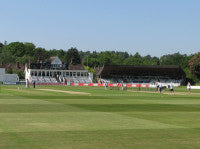
It was as a groundsman at Sunderland Rugby Club, a grassed multi sport facility winter and summer, where he got his first taste of county outground work. In the early nineties, Durham County Cricket Club was making its first steps into 1st class cricket and it was pre-Riverside days. It used the venue for 2nd eleven fixtures at this time and Jon worked under Sunderland Cricket Club head groundsman Bert Boston, who he regards as his mentor to this day.
"His approach to cricket was absolutely fantastic. He taught me how to do motties and helped me realise their importance when it comes to loam compatibility. I've always set great store by this as essential in getting quality pitches."
At thirty-one, he moved south - relatively speaking - to Hymers College, an independent school in Hull, where he was head groundsman, in charge of winter and summer sports pitches, and woodland management. Jon's feeling for cricket grew and it began to shape his career.
"I love the game, but could never play it because I'm as blind as a bat," he said with a wry smile. "Not exactly the next best thing, but looking after pitches gets you really close to the action and that's where I like to be."
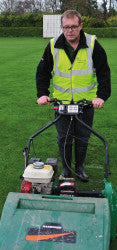
His next move was really south; to be Grounds Manager at St Edmunds School in Canterbury. It was a telling move as it turned out.
He wasn't especially looking for another fresh challenge, but noticed online a job he couldn't resist: Head Groundsman at a county outground and Sports Team Leader for Tunbridge Wells Council.
His skills and experience ticked all the boxes. Sodexo, brought in four years earlier on a ten-year contract to maintain all the town's outdoor facilities, thought so too and he was appointed. The contractor had done well for the town already in its outdoor image, securing the title of
Best in Kent and a hat trick of gold medals at the annual South and South East in Bloom competition. It was now aiming to improve further the sports pitches in its jurisdiction.
Sodexo's Contracts Manager, Dan Dibdin, emphasised what they'd been aiming for in making the appointment.
"We absolutely needed a high skills factor, a professional that would give added value to the importance of the job, especially here at the Nevill Ground," he said.
Interestingly, he told me that the company currently had a bid in place for managing the upkeep of Kent's other outground at Beckenham. Pitch success at the Nevill, therefore, has an extra significance.

"Although Simon doesn't have direct involvement in pitch preparation for Tunbridge Wells Week, he had been a little nervous of things last year," Jon said.
"Once I'd been appointed by Sodexo to look after the Nevill, I asked him if I could 'shadow' him at the St Lawrence for a couple of the Twenty20 fixtures there last summer. This was my first close up of 1st team county cricket pitch work."
"The pitches I'd prepared at Sunderland were ECB county standard, but this was a notch up from that."
"Simon put my mind at rest by saying that there was no need for him to come to the Nevill to oversee what I was doing. He did drop by a day or so before for a few minutes and told me everything was fine."
"I had felt some pressure by having to jump in at the deep end, so to speak, but Simon took a lot of this off by showing his confidence in me."
When Jon took a first close look at the square at the Nevill, he was in no doubt about the task in front of him.
"Conditions had been unfavourable for grass sown the previous autumn and I needed to groom and verti-cut it to get it into in top condition."
"Given the time I had left before last year's Cricket Week matches, my course of action was to water to a depth, roll regularly, and sheet rather than use covers so that the water filtrated better and evaporation was minimised. I must say it worked sufficiently well to see that the Championship game against Essex ran its course, and it was amazing and very gratifying that it was a record breaker for Kent."
"I knew it would have to be a different autumn routine once the season was over to get better pitches for the 2016 Cricket Week. It's two cracking local derbies I believe, Sussex in the Championship, and a Twenty20 against Surrey."
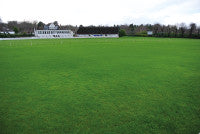
"There are two problems with the outfield here; the underlying heavy clay that means excess water lays on the surface, and a high level of thatch. These together mean that the sportsfield drains every five metres are not working efficiently," said Jon.
Rebuilding the drainage was beyond Jon's remit and budget. He estimated an outlay of £70,000 plus would be necessary for this. He had recommended a complete in-house refurbishment of the outfield though. This meant the ground's other tenants, Tunbridge Wells Hockey Club, playing their home fixtures this season at nearby Hawkenbury's all-weather pitch.
"The previous spec for the contract was to maintain the outfield in generally good condition, and boxing-off cuttings was not part of that. I've changed that, but my plan is to remove unwanted vegetation with a couple of passes of a scarifier and collector, then verti-drain, slit tine and sarrel roll, followed by brush-in seeding, fertilising and topdressing with 350 tonnes of sportsfield sand."
Jon's initiative was on a frustrating mid-winter hold because of the wet conditions.
"Weather permitting, I shall now try to renovate at the end of February, reducing the level of sand though."

Jon recalls how his mentor Bert at Sunderland Cricket Club used to get valuable tips on preparation from the then Edgbaston head groundsman, Steve Rouse. Likewise, he tells me, he was looking forward to going up to Lord's in the coming weeks to pick Mick Hunt's brains on pre-season rolling. If you want to achieve quality, consult the best.
An R9 seed mix was used in the autumn to reseed the square. He'd used it during the second half of last season for repairs at the ends. It looks wonderfully verdant and fully covered on this raw January day. All of the horizontal growth, crowns and grass stars Jon noticed when he first arrived had been eradicated.
Jon is quick to point out that it is grass management that makes the telling difference, not merely the seed.
"The top half dozen grass seed breeders each have pretty decent mixtures that would do the job. All us groundsmen are indebted to the extensive research that is carried out by the seed industry. What seed you actually use is just a personal preference. If you get your management system in place, the grass of your choice will perform."
The Nevill Ground is self-sufficient in equipment courtesy of Sodexo. The only exception is the Waterhog sponge roller for surface water removal, which belongs to Kent CCC at Canterbury. This is brought to the ground for the duration of Tunbridge Wells Cricket Week. Luckily, Jon didn't have to use it for his first Cricket Week though, looking around, it would be over-worked if cricket were a winter game.

"It's always been my opinion that we are here to provide a complete service. I know something about looking after grass hockey pitches on a cricket outfield. It was one of the jobs I had to do at Sunderland Cricket Club, so I'm ready for it and looking forward to it."
"Right now, getting people to think of the Nevill Ground as a cricket venue with quality pitches is my first priority."
Jon has three experienced assistant groundsmen to rely on here at the Nevill and for all of the facilities in Sodexo's care: Tony Field, Adam Hogg and Dave Boakes.
The ground is noted - not just by E W Swanton, but by many a cricket watcher - for its rhododendrons. These used to be a colourful backdrop for the Cricket Week when, until a couple of seasons back, it was held for close on a century in late May early June. As Tunbridge Wells Club Chairman Mark Williams had earlier told me, this date switch was a strategic decision by the county as four of the five previous seasons had been wash-outs. The day I'm there, Tony Field is giving a stretch of 'rhodies' a hard mid-winter prune. They'll be a joy as always.
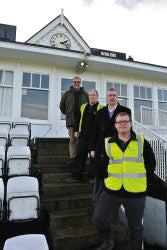
An event of notable and infamous significance occurred in 1913, when the original pavilion was destroyed by deliberate fire at the hand of the Suffragettes. In 1995, the Bluemantle Stand was erected on the site of the fire, bearing the name of another local cricket club, which has been using the ground since Victorian times. This permanent source of undercover seating is popular with both cricket and hockey watchers.
Two cricket records, other than last year's massive Kent innings, are firmly inked in the book alongside the name of the Nevill Ground. In the same year as the Suffragette fire, Kent dismissed Warwickshire for just 16 in a Championship match and this remains the lowest score by a 1st class team against the county. Even less to boast about, given the current drive by Jon to get things faster and truer, is the single day in 1960 when 30 wickets fell in a Championship game against Worcestershire and the match was concluded before stumps with two of the three days left to play. This is the last 1st class match to finish on the first day.
Last year, the Nevill Ground was named as one of the best outgrounds in the country by The Independent newspaper and it seems the new July Cricket Week is already proving successful, even without the rhododendrons in flower. The weather can be more helpful later in the summer and the huge cricket following in the Tunbridge Wells area will always be very supportive.
Tunbridge Wells Cricket Week has a great history and it gives people in this part of the county the opportunity of enjoying county cricket in two versions of the game. Jon will be doing his best to see that they do.
